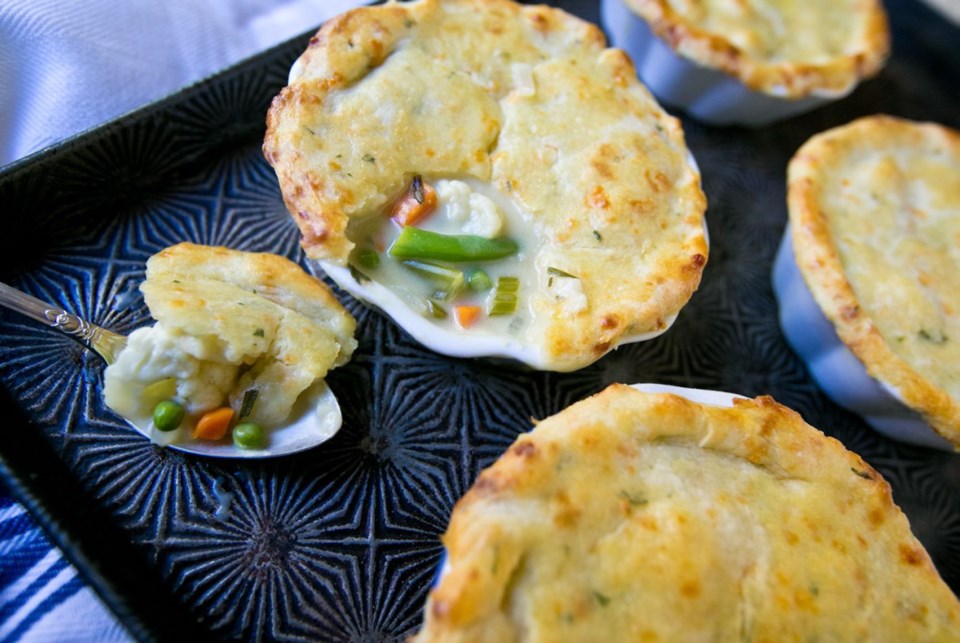 Lately, I’ve had a hankering to make pot pie, but without meat. Making vegetables the star of an entrée more often was a food trend predicted for this year. I’ve been trying to do that and this seemed like a dish that could meet that goal.
Lately, I’ve had a hankering to make pot pie, but without meat. Making vegetables the star of an entrée more often was a food trend predicted for this year. I’ve been trying to do that and this seemed like a dish that could meet that goal.
Last week, I created that recipe for today’s column. In the process, I realized it would be published on Remembrance Day. That made me wonder if perhaps this style of vegetable-rich dish was served during the Second World War — a time when many foods, including meat, were being rationed and people were planting “victory gardens” to ensure there was an adequate supply of vegetables.
When I did some research, it turned out that in England, a savoury, vegetable-filled pie was indeed being served during the war. It was called Lord Woolton pie, and then later simply Woolton pie. Chef Francis Ladry at London’s Savoy Hotel created the recipe and named the pie after Lord Woolton, Britain’s Minister of Food from 1940 to 1943.
In England, Lord Woolton and his ministerial team were tasked with deciding what foods would be rationed and how. They also promoted ways to make do with less of what people were used to eating, while ensuring nutrition was being maintained.
Chef Ladry’s recipe met all those requirements, but was lacking in one important department.
Before I tell what that is, let me explain how the pie was made.
On April 26, 1941, the Times newspaper published a recipe for Lord Woolton pie. The simple instructions said to take one pound each of diced potatoes, cauliflower, swedes (rutabaga) and carrots, three or four spring onions, one teaspoon of vegetable extract and one teaspoon of oatmeal and cook them all together for 10 minutes with just enough water to cover.
Once that was done, the vegetable mixture was cooled and placed into a pie dish, sprinkled with parsley and covered with a crust of potatoes or wholemeal pastry. The pie was then baked until nicely browned and served hot with brown gravy.
The introduction to that recipe said that in hotels and restaurants, no less than in communal canteens, many people had tasted Lord Woolton pie and pronounced it good. The Times newspaper wrote that it was an economical dish that could be described as wholesome fare that met dieticians’ requirements for certain vitamins.
It turned out that “wholesome fare” was code for bland tasting and many sources suggest the pie was not exactly loved. But by the end of the war, eating such dishes had made a big difference. Because people were eating more vegetables, while at the same time consuming less fat, eggs, sugar and meat, Britons who survived the war were fitter and healthier than they had been before the war, or even are today.
In 2015, of course, we no longer have to deal with foods being rationed and can make a vegetable-rich pie more flavourful, while still nutritious. In my vegetable pot pie recipe, that meant using a wider range of vegetables, herbs, mustard and stock, and topping that mix of ingredients with a rich pastry flavoured with potatoes, butter and cheese.
These days, recipes are much more descriptive than they were in the 1940s. For example, in the original recipe for Woolton pie, it simply says to bake in a moderate oven until nicely browned. No mention of how long to bake, oven temperature or how to make the gravy you’re supposed to serve with it.
Times have certainly changed, because today I could not get away with leaving all that information out. But what remains the same is our gratitude toward those worked together and sacrificed so much to ensure that the Second World War was won.
Individual Veggie Pot Pies with Potato Cheddar Pastry
Nine vegetables are featured in this comforting dish topped with a rich pastry flavoured with tangy cheese. These pot pies, unbaked, freeze well. The recipe could be doubled, if desired. If you prefer to top the pot pies with mashed potatoes instead of pastry, see Eric’s options.
Preparation: 50 minutes
Cooking time: About 70 minutes
Makes: four servings
For the filling
3 Tbsp butter or vegetable oil
1/2 cup diced onion (about 1/2 medium onion)
1/2 cup diced carrot (about 1 medium carrot)
1/2 cup diced celery (1 medium celery rib)
1/2 cup diced parsnip (about 1 medium parsnip)
1 medium garlic clove, minced
3 Tbsp all-purpose flour
1/2 tsp dried tarragon
2 cups vegetable stock or broth
1/4 cup half and half (10 per cent) cream or milk
2 cups small, 1-inch (thumbnail-sized) cauliflower florets
2 Tbsp Dijon mustard
12 green beans, cut into 1-inch pieces and blanched (see Note)
1/2 cup frozen peas
• salt and white pepper to taste
For the pastry and to finish
10 oz (285 grams) Yukon gold or other yellow fleshed potatoes, peeled and cut into large evenly sized cubes (see Note)
2 Tbsp milk
1/4 cup grated cheddar cheese
2 tsp parsley
3/4 cup all-purpose flour, plus some for shaping
• pinch of salt
1/4 cup cold butter, cut into small cubes
• egg wash (1 large egg beaten with 2 tsp milk)
To make the filling, melt the butter or heat the oil in a medium pot set over medium heat. Add the onion, carrot, celery and parsnip and cook five minutes. Stir in the garlic, flour and tarragon and cook two minutes more. Slowly mix in 1/2 cup stock. When the mixture is very thick, slowly mix in the rest of the stock and the cream. Bring to a simmer and cook until lightly thickened, about eight minutes.
Stir in cauliflower, remove pot from the heat and cool filling to room temperature. When cooled, stir in the mustard, greens beans and peas. Season with salt and pepper and refrigerate the filling until needed.
To make the pastry, place the potatoes in a small pot and cover with cold water. Set on the stove over medium, to medium-high and bring to a simmer. Simmer the potatoes until tender, about 12 to 15 minutes.
Drain the potatoes well and then set back over the heat one minute to evaporate any water left in the pot. Remove from heat and thoroughly mash potatoes. Mix in the milk, cheese and parsley, then cool potatoes to room temperature.
Place the 3/4 cup flour and pinch of salt in a mixing bowl. Cut in the butter with a pastry cutter, two forks or your fingertips until thoroughly blended in, with only small specks of it still visible. Now mix in the mashed potatoes to create a soft dough.
Lightly flour a work surface and set dough on to it. Form into a ball, then press into 1-inch thick disc. Wrap the dough and rest in the refrigerator 30 minutes.
To make the pot pies, preheat the oven to 375 F. Set four single-serving baking dishes (mine were five inches wide and held 1 1/2 cups) on a parchment-paper-lined baking sheet. Divide the vegetable mixture between the dishes.
Unwrap the pastry and set back on the floured surface. Sprinkle a rolling pin and the top of the dough lightly with flour. Roll the dough into a 13-inch square. Cut the square into four, six-inch rounds.
Brush the outside of each baking dish with egg wash. Now set a round of pastry on each baking dish, crimping it around the edges to help it adhere to the dish. Brush the top of the pastry with egg wash. Use a small paring knife to make a small vent hole in the centre of each pot pie.
Bake the pot pies in the centre of the oven 45 to 50 minutes, or until the filling is bubbling and the pastry golden.
Note: One large potato should yield the amount needed for this recipe. But weigh it at the store to ensure it is 10 oz (285 g). To blanch the beans, plunge into boiling water two minutes. Drain well, cool with cold water, and then drain well again.
Eric’s options: If you don’t have time or it’s too much bother to make pastry, you could top each pot pie with mashed potatoes. To make them, simmer 1 1/2 lbs. Yukon gold or other yellow fleshed potato, peeled and cubed, until tender. Drain the potatoes well, and then thoroughly mash. Mix in 1Ú3 cup buttermilk, 11Ú2 Tbsp butter and salt and pepper to taste. Divide and top each pot pie with mashed potatoes, set on in small spoonfuls so it sits on top. Bake the pot pies at 375 F for 30 minutes, or until the vegetable mixture is hot and the potatoes are golden.
Eric Akis is the author of The Great Rotisserie Chicken Cookbook (Appetite by Random House). His columns appear in the Life section Wednesday and Sunday.



